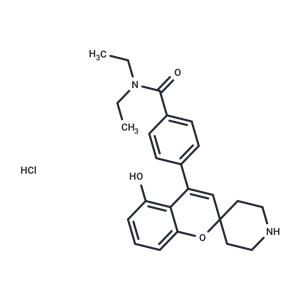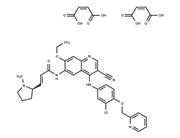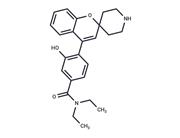| Name | ADL-5859 |
| Description | ADL-5859 (ADL5859 Hydrochloride) is a selective δ-opioid receptor agonist ( Ki: 0.8 nM), selectivity against opioid receptor κ, μ, and little inhibition for the hERG channel. |
| Cell Research | Membrane preparations from Chinese hamster ovary (CHO) cells stably expressing human κ, μ, or δ opioid receptors are prepared. The assay buffer used is composed of 50 mMtris(hydroxymethyl) aminomethaneHCl, pH 7.8, 1.0 mM ethylene glycol bis(β-aminoethyl ether)-N,N,N',N'-tetraacetic acid (EGTA free acid), 5.0 mM MgCl2 10 mg/L leupeptin, 10 mg/L pepstatin A, 200 mg/L bacitracin, and 0.5 mg/L aprotinin. After dilution in assay buffer and homogenization in a Polytron homogenizer for 30 seconds, membrane proteins (10-80 μg) in 250 μL of assay buffer are added to mixtures containing ADL5859 and [3H]diprenorphine (0.5-1.0 nM, 25000-50000 dpm) in 250 μL of assay buffer in 96-well deep-well polystyrene titer plates and incubated at room temperature for 60 minutes. Reactions are terminated by vacuum filtration with a Brandel MPXR-96T harvester through GF/B filters that have been pretreated with a solution of 0.5% polyethylenimine and 0.1% bovine serum albumin for at least 1 hour. The filters arewashed four times with 1.0 mL each of ice-cold 50 mM Tris-HCl, pH 7.8, and 30 μL of Microscint-20 is added to each filter. Radioactivity on the filters is determined by scintillation spectrometry in a Packard TopCount. [3H]Diprenorphine with a specific activity of 50 Ci/mmolisused. The Kd values for [3H]diprenorphine binding are 0.33 nM for the κ and μ receptors and 0.26 nM for the δ receptor. Receptor expression levels, determined as Bmax values from Scatchard analyses, are 4400, 4700, and 2100 fmol/mg of protein for the κ, μ, and δ receptors, respectively. Preliminary experiments are performed to show that no specific binding is lost during the wash of the filters, that binding achieved equilibrium within the incubation time and remained at equilibrium for at least an additional 60 minutes, and that binding is linear with regard to protein concentration. Nonspecific binding, determined in the presence of 10 μM unlabeled naloxone, is less than 10% of total binding.Protein is quantified by the method of Bradford. The data from competition experiments are fit by nonlinear regression analysis with the program Prism using the four-parameter equation for one-site competition, and Ki values are subsequently calculated from EC50 values by the Cheng-Prusoff equation.(Only for Reference) |
| In vitro | ADL5859 agonizes δ-opioid receptor with a 1000-fold selectivity than μ- or κ-opioid receptor with Ki of 32 nM and 37 nM, respectively.ADL5859 displays weak inhibitory activity at the hERG channel with an IC50 of 78 μM. The EC50 of ADL5859 against δ opioid receptor is 20 nM.[1] |
| In vivo | At the screening dose of 3 mg/kg p.o., ADL5859 produces 100% reversal of hyperalgesia in the inflamed paw. The oral ED50 of ADL5859 in the FCA mechanical hyperalgesia assay is 1.4 mg/kg. The antihyperalgesia produced by ADL5859 (3 mg/kg, p.o.) is reversed by pretreatment with the δ opioid antagonist naltrindole (0.3 mg/kg s.c.), thus demonstrating a δ receptor mediated effect.In the rat forced swim assay, ADL5859 (3 mg/kg p.o.) produces robust antidepressant-like activity, as evidenced by a significant decrease in the time spent immobile and a significant increase in the time spent swimming. The bioavailability of ADL5859 (3 mg/kg p.o.) in rats and dogs is 33% and 66%, respectively.[1]ADL5859 efficiently reduces inflammatory and neuropathic pain mainly by recruiting δ-opioid receptors expressed by peripheral Nav1.8-expressing neurons.[2] |
| Storage | Powder: -20°C for 3 years | In solvent: -80°C for 1 year | Shipping with blue ice. |
| Solubility Information | H2O : 5 mg/mL (11.65 mM)
DMSO : 35 mg/mL (81.59 mM), Sonication is recommended.
Ethanol : 1 mg/mL (2.33 mM)
|
| Keywords | inhibit | ADL5859 | ADL 5859 | Opioid Receptor | Inhibitor | ADL 5859 Hydrochloride | ADL-5859 Hydrochloride | ADL-5859 |
| Inhibitors Related | Docusate sodium | Bevenopran | Mirtazapine | Sinomenine | (-)-Menthol | Matrine | SCH 221510 | Progesterone | Naltrexone hydrochloride | Trimebutine | Mianserin hydrochloride | Amentoflavone |
| Related Compound Libraries | Bioactive Compound Library | Anti-Neurodegenerative Disease Compound Library | Pain-Related Compound Library | Membrane Protein-targeted Compound Library | Anti-Cancer Clinical Compound Library | Drug Repurposing Compound Library | NO PAINS Compound Library | Bioactive Compounds Library Max | GPCR Compound Library | Anti-Cancer Drug Library |

 United States
United States



